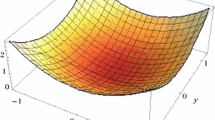Abstract
We develop a duality theory for weakly minimal points of multiple objective linear programs which has several advantages in contrast to other theories. For instance, the dual variables are vectors rather than matrices and the dual feasible set is a polyhedron. We use a set-valued dual objective map the values of which have a very simple structure, in fact they are hyperplanes. As in other set-valued (but not in vector-valued) approaches, there is no duality gap in the case that the right-hand side of the linear constraints is zero. Moreover, we show that the whole theory can be developed by working in a complete lattice. Thus the duality theory has a high degree of analogy to its classical counterpart. Another important feature of our theory is that the infimum of the set-valued dual problem is attained in a finite set of vertices of the dual feasible domain. These advantages open the possibility of various applications such as a dual simplex algorithm. Exemplarily, we discuss an application to a Markowitz-type bicriterial portfolio optimization problem where the risk is measured by the Conditional Value at Risk.
Similar content being viewed by others
References
Brumelle S (1981). Duality for multiple objective convex programs. Math Oper Res 6: 159–172
Föllmer H and Schied A (2004). Stochastic finance, 2nd edn. Walter de Gruyter, Berlin
Gerstewitz (Tammer) C (1983). Nichtkonvexe Dualität in der Vektoroptimierung. Wiss Z TH Leuna-Merseburg 25: 357–364
Göpfert A and Nehse R (1990). Vektoroptimierung. BSB B. G. Teubner Verlagsgesellschaft, Leipzig
Hamel A (2008) A duality theory for set-valued functions: conjugate duality. Set-valued Anal (submitted)
Hamel A, Heyde F, Löhne A, Tammer C and Winkler K (2004). Closing the duality gap in linear vector optimization. J Convex Anal 11: 163–178
Heyde F, Löhne A (2006) Geometric duality in multiple objective linear programming. SIAM J Optim (submitted)
Heyde F, Löhne A, Tammer C (2006) The attainment of the solution of the dual program in vertices for vectorial linear programs. In: Proceedings of the 7th international conference on multi-objective programming and goal programming. Tours, France, June 12–14 (in press)
Isermann H (1974). Proper efficiency and the linear vector maximization problem. Oper Res 22: 189–191
Isermann H (1978). On some relations between a dual pair of multiple objective linear programs. Z Oper Res Ser A 22: 33–41
Isermann H (1978). Duality in multiple objective linear programming. In: Zionts, S (eds) Multiple criteria problem solving, LN Econ. Math. Syst., vol 155, pp 274–285. Springer, Berlin
Jahn J (1986). Mathematical vector optimization in partially ordered linear spaces. Verlag Peter Lang, Frankfurt am Main
Jahn J (2004). Vector optimization. Theory, applications and extensions. Springer, Berlin
Kornbluth JSH (1974). Duality, indifference and sensitivity analysis in multiple objective linear programming. Oper Res Q 25: 599–614
Löhne A and Tammer C (2007). A new approach to duality in vector optimization. Optimization 56: 221–239
Luc DT (1989). Theory of vector optimization. Springer, Berlin
Pascoletti A and Serafini P (1984). Scalarizing vector optimization problems. J Optim Theor Appl 42: 499–524
Rockafellar RT (1972). Convex Analysis. Princeton University Press, Princeton
Rockafellar RT and Uryasev S (2000). Optimization of conditional value-at-Risk. J Risk 2: 21–41
Rockafellar RT and Uryasev S (2002). Conditional Value-at-Risk for General Loss Distributions. J Bank Financ 26: 1443–1471
Rödder W (1977). A generalized saddlepoint theory. Its application to duality theory for linear vector optimum problems. Eur J Oper Res 1: 55–59
Webster R (1994). Convexity. Oxford University Press, Oxford
Author information
Authors and Affiliations
Corresponding author
Rights and permissions
About this article
Cite this article
Heyde, F., Löhne, A. & Tammer, C. Set-valued duality theory for multiple objective linear programs and application to mathematical finance. Math Meth Oper Res 69, 159–179 (2009). https://doi.org/10.1007/s00186-008-0216-y
Received:
Revised:
Published:
Issue Date:
DOI: https://doi.org/10.1007/s00186-008-0216-y



